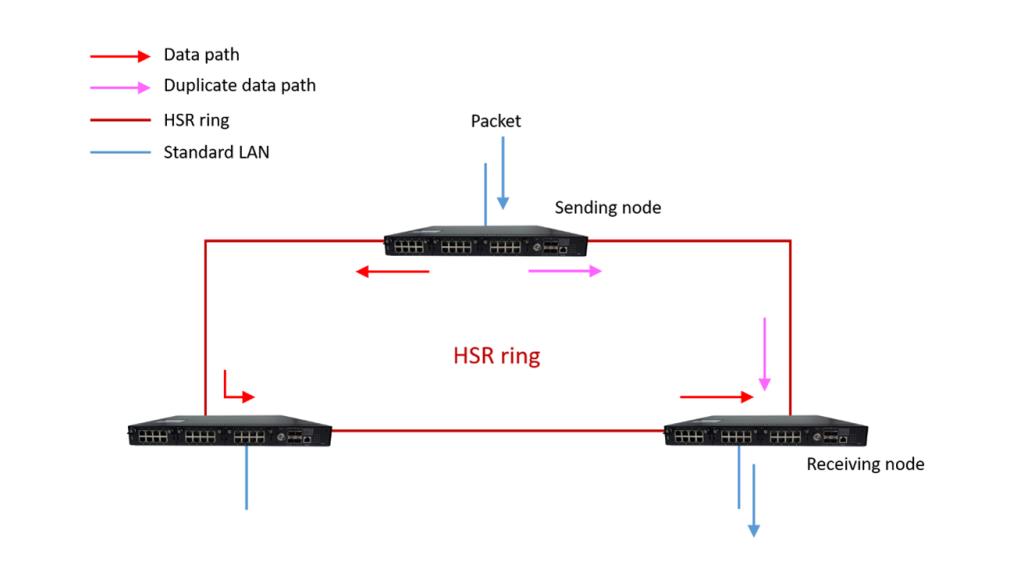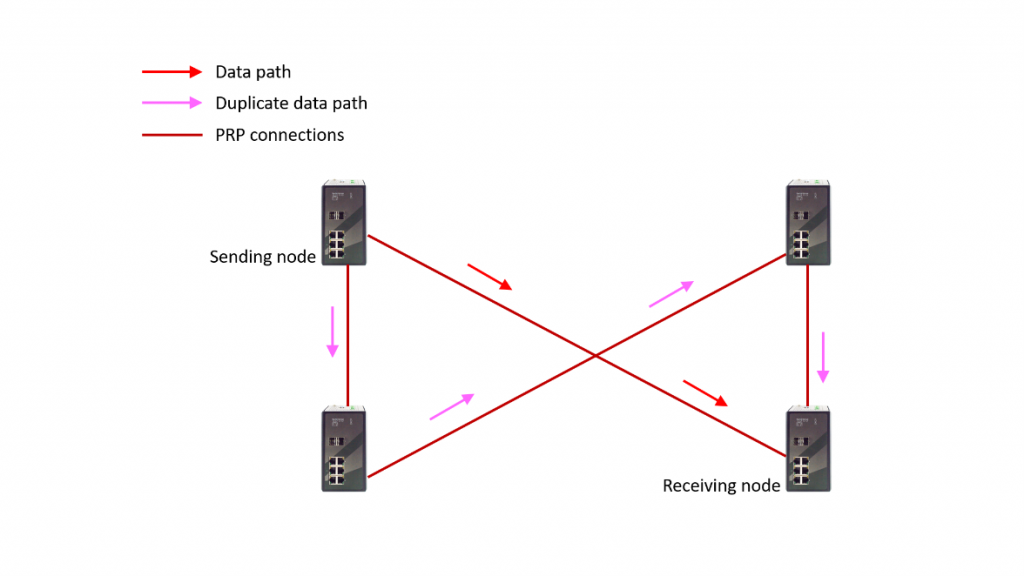junio 21, 2023
HSR and PRP: what high-availability means for power substations

Update 2024/02/26:
The Transforming Powergrid Communication article series is now available as a full brochure in PDF format. Click here to download.
To avoid errors and blackouts, substation automation must ensure strict data integrity and the least latency or downtime. Therefore, the IEC 61850 Standard adopts High-availability Seamless Redundancy and Parallel Redundancy Protocols to achieve fault-tolerant communication between devices within the power grid infrastructure. These redundancy techniques are known as hot redundancy, where redundant links are simultaneously active, thus enabling minimal switchover time.
High-availability Seamless Redundancy (HSR; IEC 62439-3 Clause 5) is a protocol designed to provide seamless and uninterrupted communication in the event of a network failure or equipment malfunction. The HSR topology is typically a ring, with each device connected by two ports to the ring. When a device sends data, it duplicates the packet and transmits it simultaneously in both directions of the ring. At the receiving end, the first arriving correct version is selected for further processing, and the duplicate or corrupted packet is discarded. In this way, HSR attains zero packet loss and high reliability.

A differentiation point of HSR from other redundancy mechanisms is that the dual ring topology allows sub-millisecond switchover without impacting real-time control and protection functions, which are crucial for the continuous operation in critical applications. Additionally, HSR’s deterministic nature ensures that data transmission occurs within predictable timeframes, making it suitable for applications where downtime or communication failures can have severe consequences for the power grid’s operation and safety, such as protection relay coordination or real-time control of substation equipment. In short, wherever precise timing is necessary on top of data integrity.
Parallel Redundancy Protocol (PRP; IEC 62439-3 Clause 4) is another redundancy protocol used in power grid communications. It also creates a redundant network topology, but instead of rings, it uses a double star topology to send duplicate data packets over two independent network paths.

The benefit of PRP is that the load on each individual connection is as of a non-redundant connection. Therefore, PRP is valuable in large-scale communication networks, such as one that involves multiple substations or interconnected systems spread over a wide area, where the primary concern may be the scalability and flexibility of the network.
PRP can easily accommodate a higher number of devices and network segments by leveraging parallel paths. Each device or network segment can have its own redundant communication path, allowing for more extensive and complex network topologies. This flexibility makes PRP suitable where the network infrastructure needs to be scalable and adaptable to changing requirements.
HSR and PRP can share the same nodes, and operate invisibly to the application, meaning that they are independent of the application-protocol and compatible with most Industrial Ethernet protocols. Yet, building an IEC 61850 network with HSR and PRP still calls for careful planning and device selection. Both protocols utilize specialized hardware that contain redundant network interfaces, are capable of duplicating and forwarding packets, and provide redundancy and seamless switchover functionalities. HSR, in particular, requires support for ring topology and usually Precision Time Protocol (PTP).
Previously, we talked about achieving precision timing in power substations through PTP. Used in conjunction with HSR/PRP, PTP helps synchronize redundant paths and ensure that all devices involved have a consistent and accurate time reference. In certain scenarios, HSR/PRP networks may require precise time-triggered operations for critical tasks, of which the effectiveness relies on PTP time alignment. PTP in these networks may need to operate separately within multiple synchronization domains, or be redundant in itself, to maintain precise time alignment within each redundant or parallel path. On the other hand, timestamping by clock nodes in a PTP network can complicate the HSR/PRP handling process, as duplicate packets are no longer identical as they move along different data paths. So, much consideration is needed to build a reliable and robust system that meets IEC 61850 standards.
For substation backbone communication, ATOP RHG9628 and RHG9528 High-Availability Managed Gigabit Switches are ideal nodes as they support HSR/PRP ports as well as PTP and advanced management features. The high-availability functions are basically plug-and-play, and the large number of modulated slots enable large-scale, flexible networks. For communication with non-HSR/PRP supporting IEDs, connect each IED to the HSR/PRP topology through a redundancy box (RedBox), and you’re good to go.
High availability measures help prevent downtime and mitigate risks, essential issues not just for public utilities, but for various industrial automation scenarios as well. To learn more about enabling high-availability in your substation or specific industrial application, reach out to our experts.